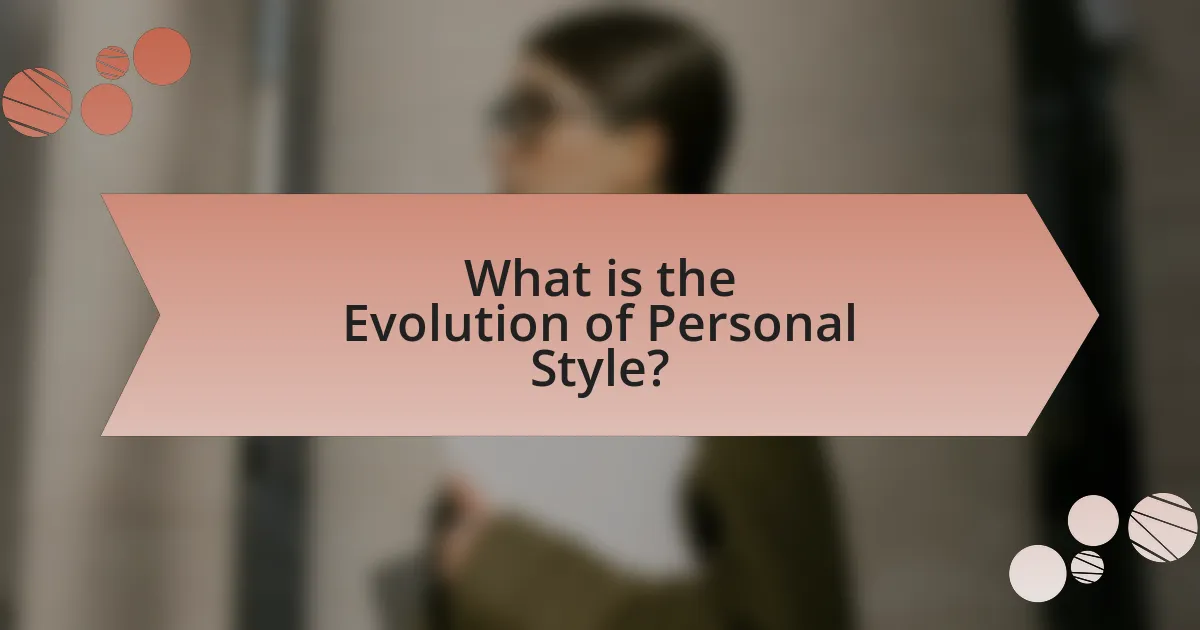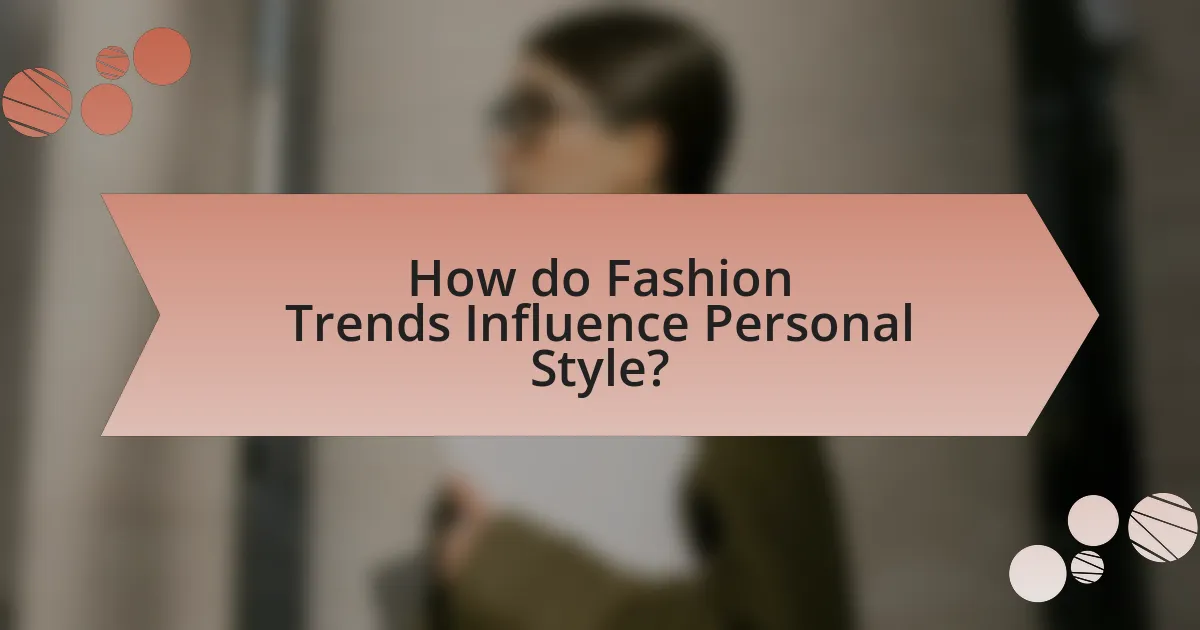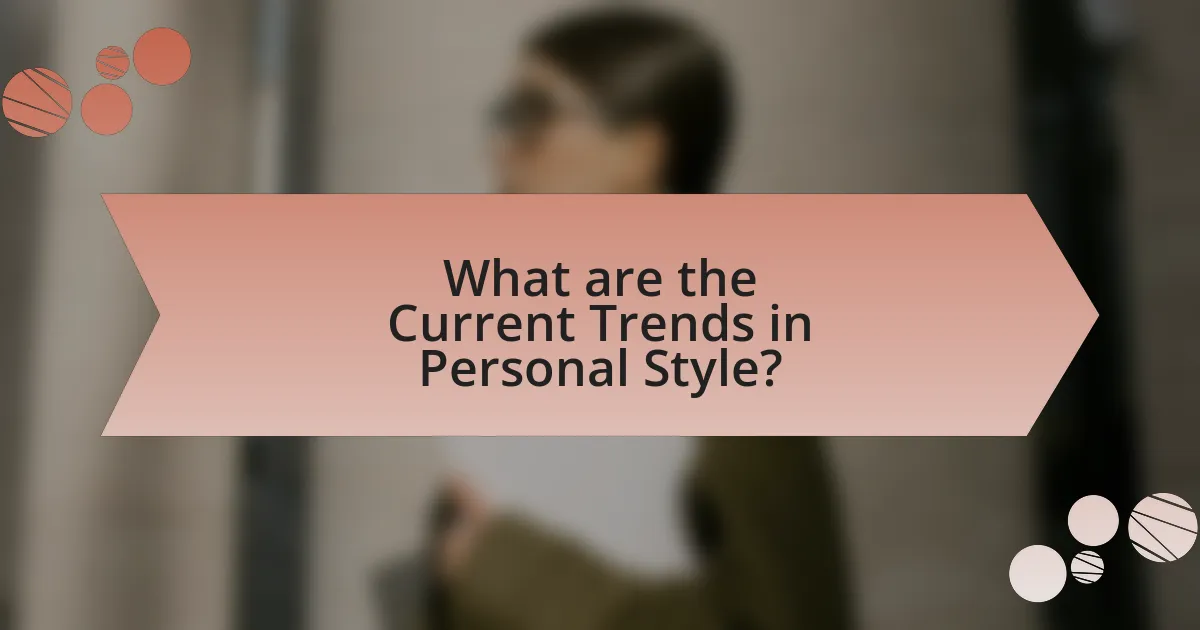The article examines the evolution of personal style and its relationship with fashion trends, highlighting how cultural shifts, technological advancements, and social movements have influenced individual expression over time. Key historical events, such as the Industrial Revolution and the women’s liberation movement, are discussed in relation to their impact on fashion trends and personal identity. The role of social media in shaping contemporary styles and the importance of personal taste in adopting trends are also explored. Additionally, the article addresses current trends emphasizing individuality, sustainability, and comfort, illustrating how individuals can curate their personal style while reflecting broader societal values.

What is the Evolution of Personal Style?
The evolution of personal style refers to the changing ways individuals express themselves through fashion over time. This evolution is influenced by cultural shifts, technological advancements, and social movements. For instance, the 1920s saw a significant change with the flapper movement, which challenged traditional gender norms and embraced a more liberated style. In the 1960s, the counterculture revolution introduced bold colors and patterns, reflecting a desire for individuality and rebellion against societal norms. The rise of social media in the 21st century has further accelerated this evolution, allowing for rapid dissemination of trends and greater access to diverse styles, enabling individuals to curate their personal aesthetics more freely.
How have fashion trends shaped personal expression over time?
Fashion trends have significantly shaped personal expression over time by providing individuals with a framework to communicate their identity, beliefs, and social status. For instance, during the 1920s, the flapper style emerged, symbolizing women’s liberation and challenging traditional gender roles, allowing women to express newfound freedoms through fashion. Similarly, the punk movement of the 1970s utilized clothing as a form of rebellion against societal norms, with distinctive styles like leather jackets and ripped jeans serving as a visual protest. These trends not only reflect cultural shifts but also empower individuals to convey their personal narratives, as evidenced by the rise of streetwear in the 21st century, which merges fashion with social commentary and personal storytelling.
What historical events have influenced changes in fashion trends?
Historical events such as the Industrial Revolution, World War I and II, and the women’s liberation movement have significantly influenced changes in fashion trends. The Industrial Revolution in the late 18th and early 19th centuries introduced mass production, making clothing more accessible and affordable, which led to the rise of ready-to-wear fashion. World War I and II brought about practical clothing styles due to resource shortages and the need for women to enter the workforce, resulting in more functional and utilitarian designs. The women’s liberation movement in the 1960s and 1970s challenged traditional gender roles, leading to the adoption of more androgynous styles and the popularization of casual wear. These events collectively shaped the evolution of fashion, reflecting societal changes and cultural shifts.
How do cultural shifts impact personal style evolution?
Cultural shifts significantly impact personal style evolution by altering societal norms, values, and aesthetics. For instance, the rise of the feminist movement in the 1960s led to women adopting more androgynous styles, reflecting a departure from traditional gender norms. This shift is evidenced by the popularity of clothing items like trousers for women, which were previously considered inappropriate. Additionally, the influence of social media in the 21st century has democratized fashion, allowing diverse styles to emerge and gain visibility, thus reshaping individual expression. The blending of global cultures through technology further accelerates this evolution, as individuals draw inspiration from various cultural backgrounds, leading to a more eclectic personal style.
Why is personal style important in individual expression?
Personal style is important in individual expression because it serves as a visual representation of one’s identity and values. This unique expression allows individuals to communicate their personality, beliefs, and cultural background without the need for words. Research indicates that clothing choices can significantly influence perceptions of self and others, as demonstrated in a study published in the Journal of Experimental Social Psychology, which found that people often make judgments about a person’s character based on their attire. Thus, personal style not only reflects individuality but also plays a crucial role in social interactions and self-perception.
What role does personal style play in identity formation?
Personal style significantly influences identity formation by serving as a means of self-expression and communication. Individuals often use their clothing choices, accessories, and overall aesthetic to convey their personality, beliefs, and social affiliations. Research indicates that personal style can reflect cultural background, social status, and individual values, thereby shaping how one is perceived by others. For instance, a study published in the Journal of Personality and Social Psychology found that people often make judgments about others’ personalities based on their clothing, which underscores the role of personal style in social identity. This interplay between personal style and identity highlights its importance in both individual self-concept and societal interactions.
How does personal style reflect societal values and norms?
Personal style reflects societal values and norms by serving as a visual representation of cultural beliefs, social status, and collective identity. For instance, fashion trends often emerge in response to significant historical events, such as the rise of feminism in the 1960s, which influenced women’s clothing to become more practical and less restrictive, symbolizing a shift towards gender equality. Additionally, the adoption of sustainable fashion practices in recent years highlights a growing societal emphasis on environmental consciousness, demonstrating how personal style can align with broader ethical values. This interplay between individual expression and societal context illustrates how personal style is not merely a matter of aesthetics but a reflection of the prevailing cultural landscape.

How do Fashion Trends Influence Personal Style?
Fashion trends significantly influence personal style by providing a framework of popular aesthetics and cultural cues that individuals often adopt to express their identity. These trends emerge from various sources, including runway shows, celebrity endorsements, and social media platforms, which collectively shape public perception of what is considered stylish. For instance, a study by the Fashion Institute of Technology found that 70% of consumers are influenced by social media trends when making fashion choices, indicating a direct correlation between trending styles and personal wardrobe selections. Consequently, individuals often modify their clothing choices, accessories, and overall appearance to align with these trends, reflecting broader societal values and norms.
What are the key factors that drive fashion trends?
Key factors that drive fashion trends include cultural influences, technological advancements, and social media impact. Cultural influences, such as art, music, and historical events, shape consumer preferences and inspire designers. For instance, the punk movement in the 1970s led to the adoption of edgy styles that reflected rebellion. Technological advancements, like the rise of fast fashion, enable rapid production and distribution, allowing trends to emerge and evolve quickly. Social media platforms, particularly Instagram and TikTok, amplify trends by providing a space for influencers and consumers to showcase styles, leading to viral fashion moments. These factors collectively create a dynamic environment where fashion trends are continuously shaped and reshaped.
How do designers and influencers shape public perception of style?
Designers and influencers shape public perception of style by setting trends and creating aspirational imagery that resonates with consumers. Designers, through runway shows and collections, introduce innovative concepts that often become benchmarks for fashion. Influencers amplify these trends by showcasing them on social media platforms, where their large followings can lead to widespread adoption. For instance, a study by the Fashion Institute of Technology found that 70% of consumers are influenced by social media when making fashion purchases, highlighting the significant impact of influencers in shaping style perceptions.
What impact do social media platforms have on fashion trends?
Social media platforms significantly influence fashion trends by enabling rapid dissemination and democratization of style ideas. These platforms allow users to share images, videos, and opinions, which can lead to viral trends that spread quickly across diverse demographics. For instance, a study by the Pew Research Center found that 72% of teens use Instagram, where fashion influencers often showcase new styles, directly impacting purchasing decisions and trend adoption among their followers. Additionally, platforms like TikTok have introduced trends such as “outfit challenges,” which encourage users to participate and create their own interpretations, further shaping the fashion landscape. This interconnectedness fosters a culture where trends can emerge from various sources, not just traditional fashion houses, thus altering how fashion is defined and consumed.
How do individuals adapt fashion trends to create their personal style?
Individuals adapt fashion trends to create their personal style by selectively incorporating elements of current trends that resonate with their identity and preferences. This process often involves mixing and matching pieces from various trends, customizing garments, and adding unique accessories to reflect personal taste. For instance, a study by the Fashion Institute of Technology found that 70% of consumers prefer to personalize their clothing to express individuality, demonstrating that personal expression is a significant factor in how trends are adapted. By doing so, individuals not only stay relevant to contemporary fashion but also ensure their style remains distinct and authentic.
What strategies do people use to incorporate trends into their wardrobe?
People incorporate trends into their wardrobe by selectively integrating key pieces that reflect current styles while maintaining their personal aesthetic. This strategy often involves researching fashion trends through social media platforms, fashion blogs, and runway shows to identify popular items. Additionally, individuals may choose to invest in versatile staple pieces that can be styled in multiple ways, allowing them to adapt to changing trends without overhauling their entire wardrobe. For instance, a study by the Fashion Institute of Technology found that 70% of consumers prefer to mix trendy items with classic pieces to create a balanced look. This approach not only keeps their style fresh but also ensures longevity in their clothing choices.
How does personal taste influence the adoption of trends?
Personal taste significantly influences the adoption of trends by determining an individual’s preferences and choices in style. When individuals resonate with a trend that aligns with their personal aesthetics, they are more likely to embrace and incorporate it into their wardrobe. For instance, a study published in the Journal of Consumer Research indicates that personal identity and self-expression play crucial roles in how people select fashion trends, suggesting that individuals adopt trends that reflect their unique tastes and values. This alignment between personal taste and trends fosters a deeper connection, making individuals more inclined to adopt and promote those trends within their social circles.

What are the Current Trends in Personal Style?
Current trends in personal style emphasize individuality, sustainability, and comfort. Individuals increasingly prioritize unique expressions of self through fashion, often blending vintage and contemporary pieces to create personalized looks. The rise of sustainable fashion reflects a growing awareness of environmental impact, with many opting for eco-friendly materials and ethical brands. Comfort has also become paramount, with athleisure and relaxed silhouettes dominating wardrobes, as seen in the popularity of oversized clothing and loungewear. These trends are supported by social media platforms, where influencers showcase diverse styles, further encouraging personal expression and the blending of various fashion influences.
What are the most popular fashion trends today?
The most popular fashion trends today include oversized silhouettes, sustainable fashion, and bold colors. Oversized clothing, such as baggy jeans and large blazers, has gained traction due to its comfort and relaxed aesthetic. Sustainable fashion is increasingly prioritized, with brands focusing on eco-friendly materials and ethical production methods, reflecting a growing consumer awareness of environmental issues. Bold colors, particularly vibrant hues and color-blocking, are trending as individuals seek to express their personality and creativity through their wardrobe choices. These trends are supported by fashion industry reports indicating a shift towards comfort, sustainability, and self-expression in contemporary fashion.
How do sustainability and ethical fashion influence current trends?
Sustainability and ethical fashion significantly influence current trends by prioritizing environmentally friendly practices and social responsibility in the fashion industry. This shift has led to increased consumer demand for brands that demonstrate transparency, use sustainable materials, and ensure fair labor practices. For instance, a 2021 McKinsey report highlighted that 67% of consumers consider sustainability when making a purchase, indicating a strong preference for brands that align with these values. Consequently, many fashion companies are adopting circular economy principles, such as recycling and upcycling, to meet this demand, thereby shaping contemporary fashion trends towards more responsible consumption and production.
What role does technology play in shaping modern fashion trends?
Technology plays a crucial role in shaping modern fashion trends by enabling rapid design, production, and distribution processes. Innovations such as 3D printing allow designers to create intricate garments quickly, while digital platforms facilitate immediate consumer feedback, influencing design choices. Additionally, data analytics helps brands understand consumer preferences, leading to more targeted marketing strategies. For instance, the rise of social media platforms has transformed how trends spread, with influencers driving fashion choices in real-time. This interconnectedness between technology and fashion not only accelerates trend cycles but also democratizes fashion, allowing diverse voices to influence mainstream styles.
How can individuals express their unique style within current trends?
Individuals can express their unique style within current trends by selectively incorporating trendy elements that resonate with their personal preferences and identity. This approach allows individuals to blend popular fashion items with their own distinctive choices, such as mixing high-street brands with vintage pieces or customizing clothing through alterations and accessories. Research indicates that personal style is often a reflection of individual identity, with studies showing that 70% of people feel more confident when their clothing aligns with their personal taste, even when influenced by trends. By curating a wardrobe that balances current trends with personal flair, individuals can authentically express themselves while remaining fashionable.
What tips can help individuals curate a personal style that reflects current trends?
To curate a personal style that reflects current trends, individuals should focus on incorporating key elements from contemporary fashion while ensuring authenticity. This can be achieved by researching current fashion trends through platforms like social media, fashion blogs, and runway shows, which provide insights into popular styles and color palettes. Additionally, individuals should assess their body type and personal preferences to select pieces that enhance their unique features, ensuring that their style remains true to themselves.
For instance, a study by the Fashion Institute of Technology highlights that understanding one’s body shape can significantly influence clothing choices, leading to a more confident personal style. Furthermore, mixing high-end pieces with affordable items can create a balanced look that reflects current trends without compromising personal identity.
How can one balance trendiness with personal authenticity?
To balance trendiness with personal authenticity, individuals should selectively incorporate current trends that resonate with their personal values and style. This approach allows for the expression of individuality while remaining relevant in the fashion landscape. Research indicates that personal style is often a reflection of self-identity, and aligning trends with personal preferences fosters a genuine representation of oneself. For instance, a study published in the Journal of Fashion Marketing and Management highlights that consumers who integrate trends that align with their self-concept report higher satisfaction and confidence in their style choices. Thus, by curating trends that complement their authentic selves, individuals can achieve a harmonious balance between being trendy and true to themselves.
